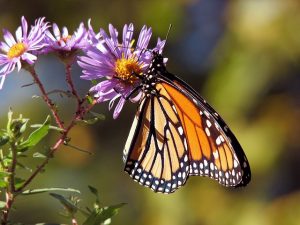 When I experienced my butterfly revelation, I learned yet again that nature’s light-bulb moments may come in very small packages. It began at the end of August when I spotted a monarch butterfly chrysalis
When I experienced my butterfly revelation, I learned yet again that nature’s light-bulb moments may come in very small packages. It began at the end of August when I spotted a monarch butterfly chrysalis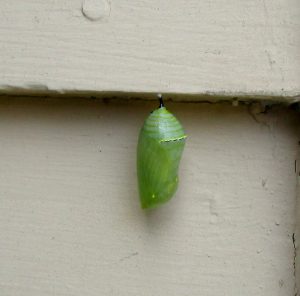 attached to a clapboard beside my front door where I couldn’t miss it. This surprised me because, despite a lot of chewed up milkweed, I’d seen very few monarch caterpillars, no evidence of chrysalises and very few adults. Perhaps this was the butterfly’s way of reminding me that this wasn’t so.
attached to a clapboard beside my front door where I couldn’t miss it. This surprised me because, despite a lot of chewed up milkweed, I’d seen very few monarch caterpillars, no evidence of chrysalises and very few adults. Perhaps this was the butterfly’s way of reminding me that this wasn’t so.
At the time, I attributed the lack of sightings to the alternating cycles of abnormal heat, cold, and heavy rains that repeatedly assaulted my carefully selected cultivated flowering plants all summer. My butterfly bushes didn’t survive, the phlox flowers teetered on scrawny stalks covered by powdery mildew. Weeds sprang up faster than political ads before an election. The erratic weather begat an equally erratic outdoor work schedule that resulted in large clumps of crab grass that filled any areas I’d cleared of rampant weeds mere days before. I could never get ahead.
But seeing that monarch chrysalis attached at eye level by my front door changed all that. It switched me from a state of weary gardening defeat to panic mode. It triggered a flood of thoughts with the same theme: “What is this butterfly going to eat when it hatches!” In that instant, my entire perception of my gardens changed. Instead of focusing on the pathetic remnants of my carefully chosen cultivated plants, I looked at the weeds I’d gleefully ripped out in the past. Those plants I’d devoted so much energy to cursing for ruining my flower garden over the years. I looked at any flower anywhere on my land and noted any signs of insect activity.
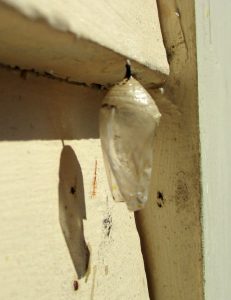 During the days between when the chrysalis first appeared, the fully developed adult made its presence
During the days between when the chrysalis first appeared, the fully developed adult made its presence 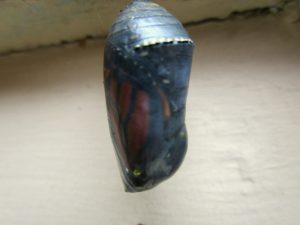 known within it, and then disappeared the next day. I spent a lot of time looking at—really looking at—and reading about those indigenous species, a.k.a. weeds, and other plants flowering at that time. Which ones could provide the nourishment the late season migrating butterflies needed to survive? Which ones attracted honeybees and other beneficial insect species? During this period I found the information provided by the Xerces Society for Invertebrate Conservation especially helpful.
known within it, and then disappeared the next day. I spent a lot of time looking at—really looking at—and reading about those indigenous species, a.k.a. weeds, and other plants flowering at that time. Which ones could provide the nourishment the late season migrating butterflies needed to survive? Which ones attracted honeybees and other beneficial insect species? During this period I found the information provided by the Xerces Society for Invertebrate Conservation especially helpful.
Armed with the New England native plant, shrub, and tree list from the Xerces site, I then looked up pictures of their foliage and flowers. That’s when the enormity of my hubris hit me. Time and time again, I discovered plants on the list that I’d routinely ripped out in favor of more cultivated species I’d planted over the years. I discovered plants I “allowed” in my gardens that I perceived as weeds. I’ve cursed them, yanked them out, and didn’t care if I stepped on them or ran over them with my garden cart or mower. Some of them I openly declared war on sans any form of chemical weapons; just shear brutality. Even the ones I was nice to because they grew in a thin layer soil atop a granite ledge mere inches below.
As I walked around my yard, my horror grew in proportion to the length of my list.
But luckily for my fledgling butterfly, these tough botanical survivors persevered. As I observed them, I recalled a poem- Invictus, by William Earnest Henley – we seventh-graders had to memorize and recite in front of the class:
Out of the night that covers me,
Black as the Pit from pole to pole,
I thank whatever gods may be
For my unconquerable soul.
In the fell clutch of circumstance
I have not winced nor cried aloud.
Under the bludgeonings of chance
My head is bloody, but unbowed.
Beyond this place of wrath and tears
Looms but the Horror of the shade,
And yet the menace of the years
Finds, and shall find, me unafraid.
It matters not how strait the gate,
How charged with punishments the scroll,
I am the master of my fate:
I am the captain of my soul.
Oh, the agony and determination to master the cruel world poured into those words 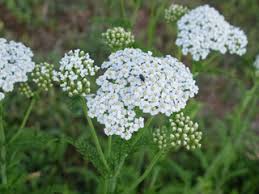 as we recited this to the class! Surely my monarch-friendly wild geraniums, scrawny common yarrow, crown vetch, evening primrose,
as we recited this to the class! Surely my monarch-friendly wild geraniums, scrawny common yarrow, crown vetch, evening primrose, 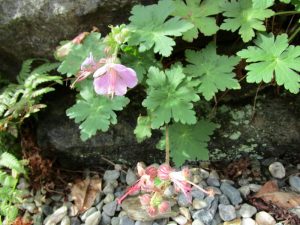 vervain mallow, little yellow daisy-like flowers that persist beside the driveway surrounded by Joe Pye weed, spiderworts, waves of
vervain mallow, little yellow daisy-like flowers that persist beside the driveway surrounded by Joe Pye weed, spiderworts, waves of 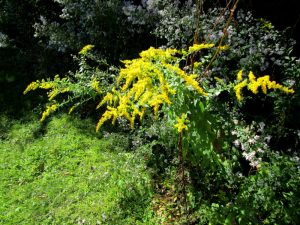 golden rod, wild asters, and impenetrable thickets of wild black raspberries have summoned similar fortitude in the face of my assaults!
golden rod, wild asters, and impenetrable thickets of wild black raspberries have summoned similar fortitude in the face of my assaults!
But once I saw that chrysalis beside my front door, that all changed. I give thanks for every determined wild flower out there. I gave thanks for those hardly late season bloomers that survived the increasingly unpredictable weather. I gave thanks that they could nourish the late season migrating butterflies as well as the masses of honey and bumble bees I saw feeding on them.
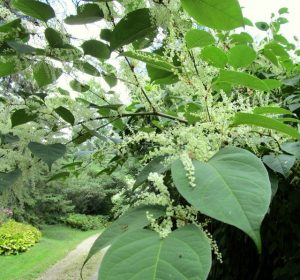 Unfortunately, the tale doesn’t end there. No clean redemption for me that enables me to align myself with those sometimes smug only-native plants folks. Nor can I claim any moral high ground associated with my on-going overt loathing of the invasive species on my land. Granted most of my flowering weeds are native ones. The botanical butterfly-friendly elephant in the pollinator closet surrounding the little house on the hill is my most hated resident. The highly invasive Japanese knotweed, a.k.a., American bamboo.
Unfortunately, the tale doesn’t end there. No clean redemption for me that enables me to align myself with those sometimes smug only-native plants folks. Nor can I claim any moral high ground associated with my on-going overt loathing of the invasive species on my land. Granted most of my flowering weeds are native ones. The botanical butterfly-friendly elephant in the pollinator closet surrounding the little house on the hill is my most hated resident. The highly invasive Japanese knotweed, a.k.a., American bamboo.
Not only does a vibrating cloud of honey and other bees and pollinators descend on the flowers in late August through early September (depending on the weather), I’ve seen monarchs and other butterflies on the knotweed’s masses of tiny flowers too. It also seems like there are more of them there every year. As well as on the weeds. Could this marauding botanical hoard provide those insects with something the cultivated flowering plants in my gardens couldn’t?
After giving this some thought, I realized that all of these uninvited and often unwanted botanical guests could provide the butterflies, honeybees and other pollinators with one thing my cultivated plants could not: a reliable food supply in an increasingly unpredictable climate. Compared to them, those garden party-crashers possessed more genetic diversity. This made it easier for them to adapt more rapidly to changes in the climate.
That’s especially important–or should have been–to me right along. I live roughly 100 miles from the Gulf of Maine, a body of water infamous for possessing the highest increase in sea temperature of any area in the Atlantic ocean. My home is located between the White Mountains and its foothills to the east, and the Green Mountains and its foothills to the west. My home is tucked in a narrow river valley surrounded by hills. In short, I’m surrounded by natural idiosyncratic climatic environments within other idiosyncratic natural climatic environments within other such environments.
Meanwhile my “chosen” flowers, trees, and shrubs increasingly communicate that they’re having trouble evolving fast enough to keep up. As various species of cultivated plants succumb to the effects of climate change, the butterflies and other invertebrates must adapt to survive. Enter the native flowering weeds and some exotic invasives I love to hate with the potential to save them.
Growing up, I often heard the expression “A little bird told me.” This time it was a little butterfly whose message came through loud and clear.
At the time, I attributed the lack of sightings to the alternating cycles of abnormal heat, cold, and heavy rains that repeatedly assaulted my carefully selected cultivated flowering plants all summer. My butterfly bushes didn’t survive, the phlox flowers teetered on scrawny stalks covered by powdery mildew. Weeds sprang up faster than political ads before an election. The erratic weather begat an equally erratic outdoor work schedule that resulted in large clumps of crab grass that filled any areas I’d cleared of rampant weeds mere days before. I could never get ahead.
But seeing that monarch chrysalis attached at eye level by my front door changed all that. It switched me from a state of weary gardening defeat to panic mode. It triggered a flood of thoughts with the same theme: “What is this butterfly going to eat when it hatches!” In that instant, my entire perception of my gardens changed. Instead of focusing on the pathetic remnants of my carefully chosen cultivated plants, I looked at the weeds I’d gleefully ripped out in the past. Those plants I’d devoted so much energy to cursing for ruining my flower garden over the years. I looked at any flower anywhere on my land and noted any signs of insect activity.
Armed with the New England native plant, shrub, and tree list from the Xerces site, I then looked up pictures of their foliage and flowers. That’s when the enormity of my hubris hit me. Time and time again, I discovered plants on the list that I’d routinely ripped out in favor of more cultivated species I’d planted over the years. I discovered plants I “allowed” in my gardens that I perceived as weeds. I’ve cursed them, yanked them out, and didn’t care if I stepped on them or ran over them with my garden cart or mower. Some of them I openly declared war on sans any form of chemical weapons; just shear brutality. Even the ones I was nice to because they grew in a thin layer soil atop a granite ledge mere inches below.
As I walked around my yard, my horror grew in proportion to the length of my list.
But luckily for my fledgling butterfly, these tough botanical survivors persevered. As I observed them, I recalled a poem- Invictus, by William Earnest Henley – we seventh-graders had to memorize and recite in front of the class:
Out of the night that covers me,
Black as the Pit from pole to pole,
I thank whatever gods may be
For my unconquerable soul.
In the fell clutch of circumstance
I have not winced nor cried aloud.
Under the bludgeonings of chance
My head is bloody, but unbowed.
Beyond this place of wrath and tears
Looms but the Horror of the shade,
And yet the menace of the years
Finds, and shall find, me unafraid.
It matters not how strait the gate, as we recited this to the class! Surely my monarch-friendly wild geraniums, scrawny common yarrow, crown vetch, evening primrose,
as we recited this to the class! Surely my monarch-friendly wild geraniums, scrawny common yarrow, crown vetch, evening primrose,  vervain mallow, little yellow daisy-like flowers that persist beside the driveway surrounded by Joe Pye weed, spiderworts, waves of
vervain mallow, little yellow daisy-like flowers that persist beside the driveway surrounded by Joe Pye weed, spiderworts, waves of  golden rod, wild asters, and impenetrable thickets of wild black raspberries have summoned similar fortitude in the face of my assaults!
golden rod, wild asters, and impenetrable thickets of wild black raspberries have summoned similar fortitude in the face of my assaults!
How charged with punishments the scroll,
I am the master of my fate:
I am the captain of my soul.
Oh, the agony and determination to master the cruel world poured into those words
But once I saw that chrysalis beside my front door, that all changed. I give thanks for every determined wild flower out there. I gave thanks for those hardly late season bloomers that survived the increasingly unpredictable weather. I gave thanks that they could nourish the late season migrating butterflies as well as the masses of honey and bumble bees I saw feeding on them.
Not only does a vibrating cloud of honey and other bees and pollinators descend on the flowers in late August through early September (depending on the weather), I’ve seen monarchs and other butterflies on the knotweed’s masses of tiny flowers too. It also seems like there are more of them there every year. As well as on the weeds. Could this marauding botanical hoard provide those insects with something the cultivated flowering plants in my gardens couldn’t?
After giving this some thought, I realized that all of these uninvited and often unwanted botanical guests could provide the butterflies, honeybees and other pollinators with one thing my cultivated plants could not: a reliable food supply in an increasingly unpredictable climate. Compared to them, those garden party-crashers possessed more genetic diversity. This made it easier for them to adapt more rapidly to changes in the climate.
That’s especially important–or should have been–to me right along. I live roughly 100 miles from the Gulf of Maine, a body of water infamous for possessing the highest increase in sea temperature of any area in the Atlantic ocean. My home is located between the White Mountains and its foothills to the east, and the Green Mountains and its foothills to the west. My home is tucked in a narrow river valley surrounded by hills. In short, I’m surrounded by natural idiosyncratic climatic environments within other idiosyncratic natural climatic environments within other such environments.
Meanwhile my “chosen” flowers, trees, and shrubs increasingly communicate that they’re having trouble evolving fast enough to keep up. As various species of cultivated plants succumb to the effects of climate change, the butterflies and other invertebrates must adapt to survive. Enter the native flowering weeds and some exotic invasives I love to hate with the potential to save them.
Growing up, I often heard the expression “A little bird told me.” This time it was a little butterfly whose message came through loud and clear.